Critical Appraisal Report: Maternal Morbidity in Postpartum Period
VerifiedAdded on 2022/08/16
|5
|1395
|20
Report
AI Summary
This report offers a critical appraisal of a research study focusing on maternal morbidity in the first year after childbirth. The study, which employed a cross-sectional survey, aimed to assess the health outcomes of mothers in Mombasa, Kenya. The appraisal analyzes the research methodology, including the selection of participants, data collection methods (interviews, clinical examinations), and the use of tools like the AUDIT for screening. The report highlights the strengths, such as the longitudinal approach, and limitations, such as the inability to generalize findings and potential for bias. Furthermore, it suggests improvements to the research design, proposing a cohort study for more robust results, including detailed data collection through interviews with nurses. The references are provided at the end.
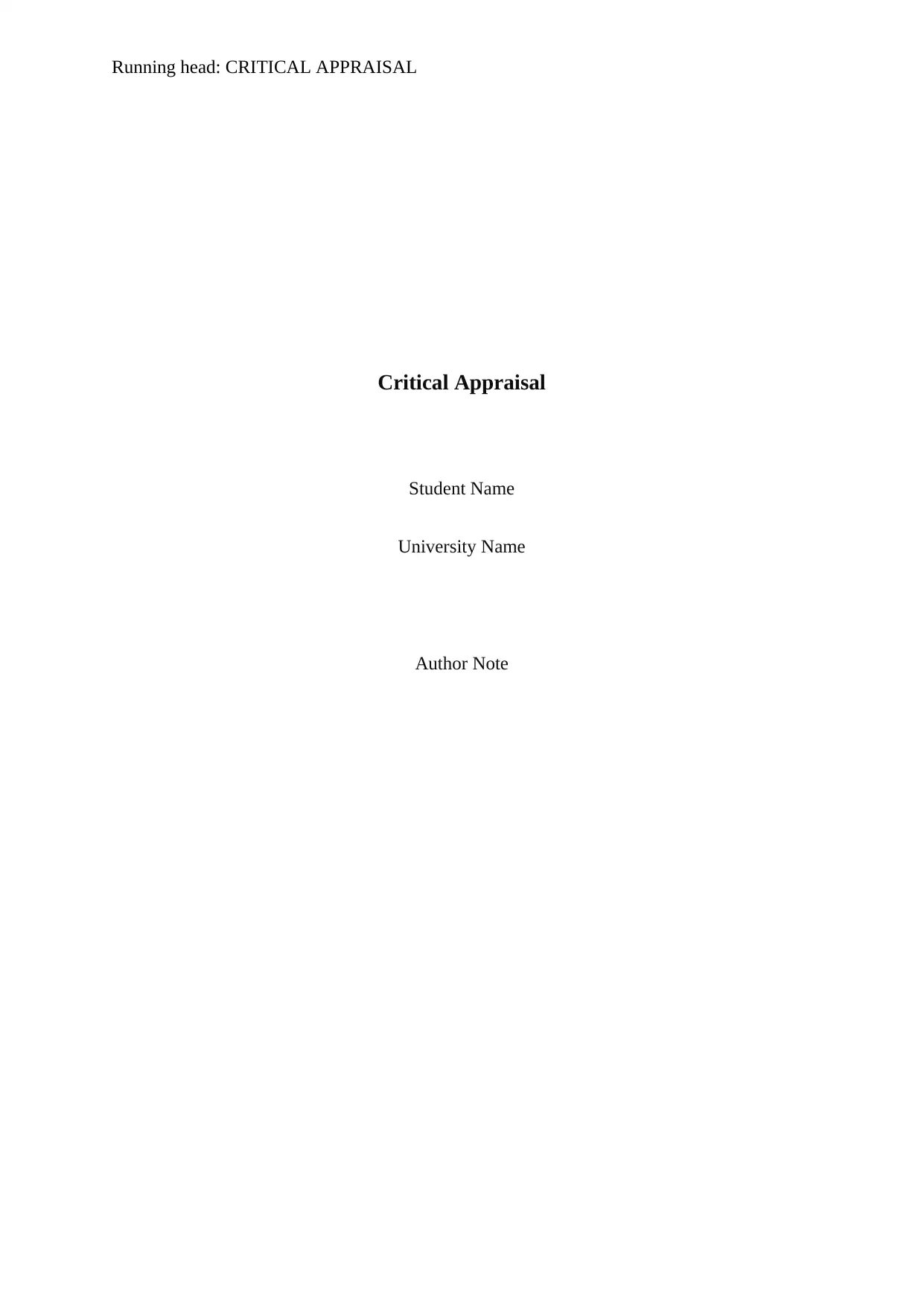
Running head: CRITICAL APPRAISAL
Critical Appraisal
Student Name
University Name
Author Note
Critical Appraisal
Student Name
University Name
Author Note
Paraphrase This Document
Need a fresh take? Get an instant paraphrase of this document with our AI Paraphraser
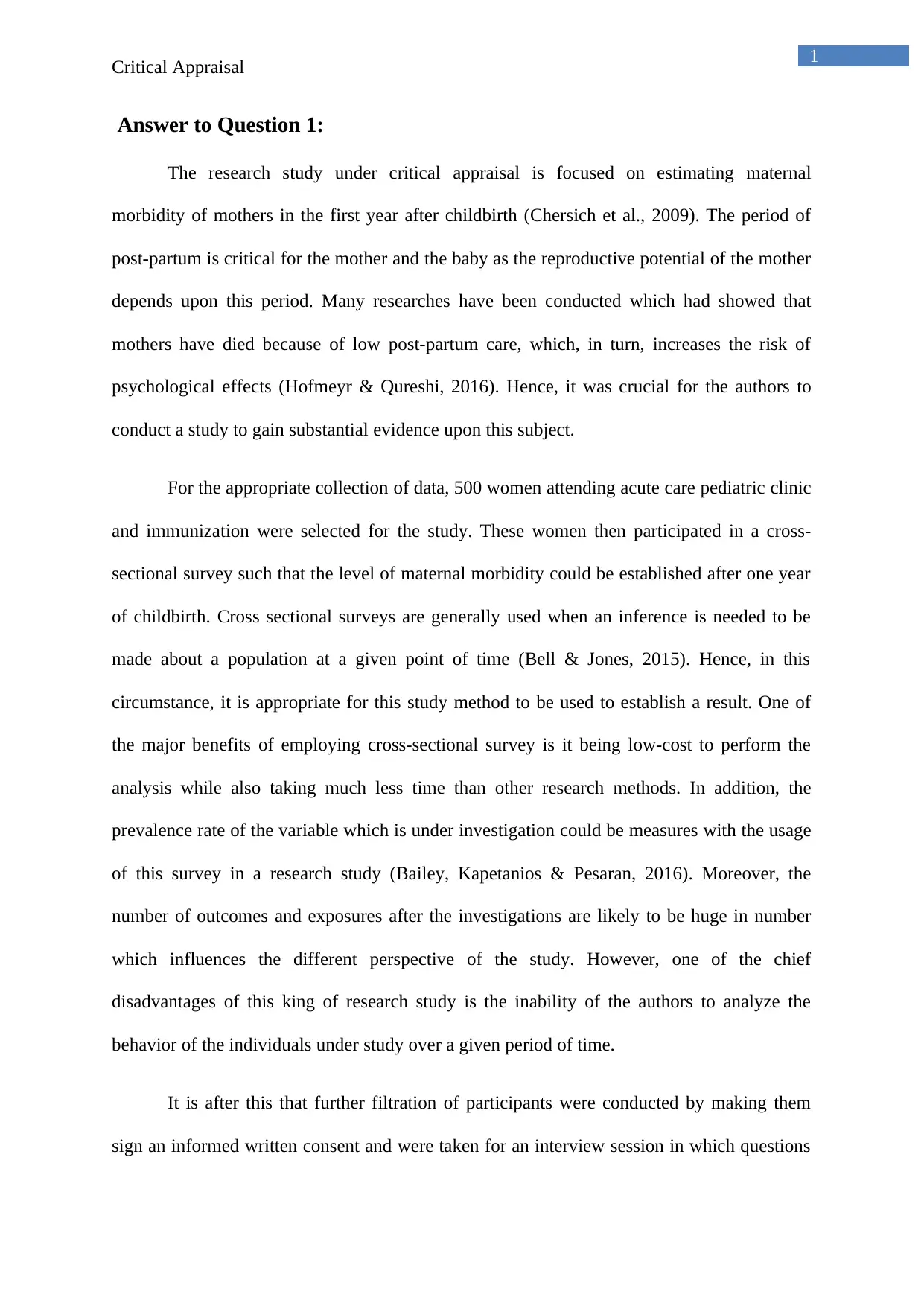
1
Critical Appraisal
Answer to Question 1:
The research study under critical appraisal is focused on estimating maternal
morbidity of mothers in the first year after childbirth (Chersich et al., 2009). The period of
post-partum is critical for the mother and the baby as the reproductive potential of the mother
depends upon this period. Many researches have been conducted which had showed that
mothers have died because of low post-partum care, which, in turn, increases the risk of
psychological effects (Hofmeyr & Qureshi, 2016). Hence, it was crucial for the authors to
conduct a study to gain substantial evidence upon this subject.
For the appropriate collection of data, 500 women attending acute care pediatric clinic
and immunization were selected for the study. These women then participated in a cross-
sectional survey such that the level of maternal morbidity could be established after one year
of childbirth. Cross sectional surveys are generally used when an inference is needed to be
made about a population at a given point of time (Bell & Jones, 2015). Hence, in this
circumstance, it is appropriate for this study method to be used to establish a result. One of
the major benefits of employing cross-sectional survey is it being low-cost to perform the
analysis while also taking much less time than other research methods. In addition, the
prevalence rate of the variable which is under investigation could be measures with the usage
of this survey in a research study (Bailey, Kapetanios & Pesaran, 2016). Moreover, the
number of outcomes and exposures after the investigations are likely to be huge in number
which influences the different perspective of the study. However, one of the chief
disadvantages of this king of research study is the inability of the authors to analyze the
behavior of the individuals under study over a given period of time.
It is after this that further filtration of participants were conducted by making them
sign an informed written consent and were taken for an interview session in which questions
Critical Appraisal
Answer to Question 1:
The research study under critical appraisal is focused on estimating maternal
morbidity of mothers in the first year after childbirth (Chersich et al., 2009). The period of
post-partum is critical for the mother and the baby as the reproductive potential of the mother
depends upon this period. Many researches have been conducted which had showed that
mothers have died because of low post-partum care, which, in turn, increases the risk of
psychological effects (Hofmeyr & Qureshi, 2016). Hence, it was crucial for the authors to
conduct a study to gain substantial evidence upon this subject.
For the appropriate collection of data, 500 women attending acute care pediatric clinic
and immunization were selected for the study. These women then participated in a cross-
sectional survey such that the level of maternal morbidity could be established after one year
of childbirth. Cross sectional surveys are generally used when an inference is needed to be
made about a population at a given point of time (Bell & Jones, 2015). Hence, in this
circumstance, it is appropriate for this study method to be used to establish a result. One of
the major benefits of employing cross-sectional survey is it being low-cost to perform the
analysis while also taking much less time than other research methods. In addition, the
prevalence rate of the variable which is under investigation could be measures with the usage
of this survey in a research study (Bailey, Kapetanios & Pesaran, 2016). Moreover, the
number of outcomes and exposures after the investigations are likely to be huge in number
which influences the different perspective of the study. However, one of the chief
disadvantages of this king of research study is the inability of the authors to analyze the
behavior of the individuals under study over a given period of time.
It is after this that further filtration of participants were conducted by making them
sign an informed written consent and were taken for an interview session in which questions
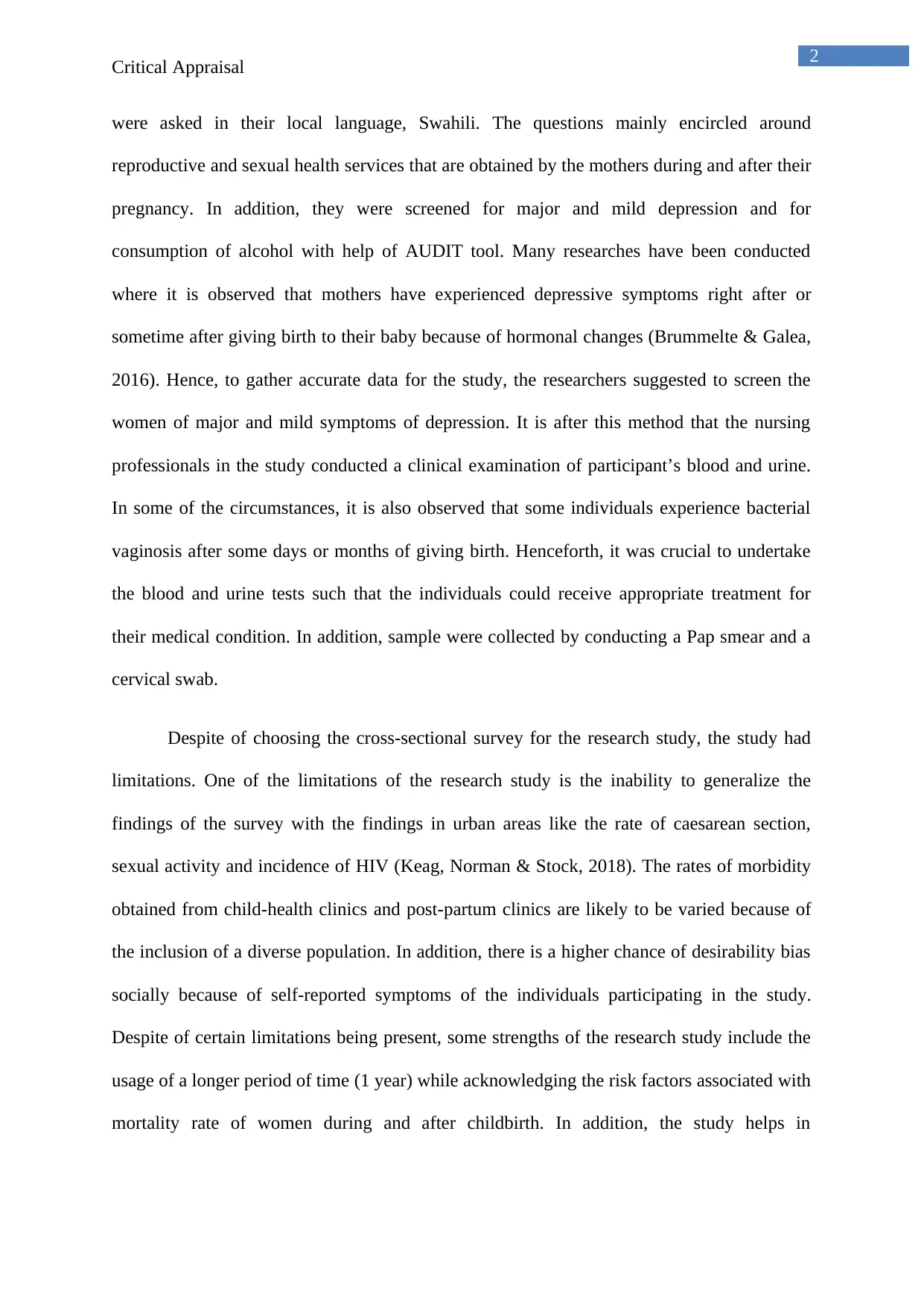
2
Critical Appraisal
were asked in their local language, Swahili. The questions mainly encircled around
reproductive and sexual health services that are obtained by the mothers during and after their
pregnancy. In addition, they were screened for major and mild depression and for
consumption of alcohol with help of AUDIT tool. Many researches have been conducted
where it is observed that mothers have experienced depressive symptoms right after or
sometime after giving birth to their baby because of hormonal changes (Brummelte & Galea,
2016). Hence, to gather accurate data for the study, the researchers suggested to screen the
women of major and mild symptoms of depression. It is after this method that the nursing
professionals in the study conducted a clinical examination of participant’s blood and urine.
In some of the circumstances, it is also observed that some individuals experience bacterial
vaginosis after some days or months of giving birth. Henceforth, it was crucial to undertake
the blood and urine tests such that the individuals could receive appropriate treatment for
their medical condition. In addition, sample were collected by conducting a Pap smear and a
cervical swab.
Despite of choosing the cross-sectional survey for the research study, the study had
limitations. One of the limitations of the research study is the inability to generalize the
findings of the survey with the findings in urban areas like the rate of caesarean section,
sexual activity and incidence of HIV (Keag, Norman & Stock, 2018). The rates of morbidity
obtained from child-health clinics and post-partum clinics are likely to be varied because of
the inclusion of a diverse population. In addition, there is a higher chance of desirability bias
socially because of self-reported symptoms of the individuals participating in the study.
Despite of certain limitations being present, some strengths of the research study include the
usage of a longer period of time (1 year) while acknowledging the risk factors associated with
mortality rate of women during and after childbirth. In addition, the study helps in
Critical Appraisal
were asked in their local language, Swahili. The questions mainly encircled around
reproductive and sexual health services that are obtained by the mothers during and after their
pregnancy. In addition, they were screened for major and mild depression and for
consumption of alcohol with help of AUDIT tool. Many researches have been conducted
where it is observed that mothers have experienced depressive symptoms right after or
sometime after giving birth to their baby because of hormonal changes (Brummelte & Galea,
2016). Hence, to gather accurate data for the study, the researchers suggested to screen the
women of major and mild symptoms of depression. It is after this method that the nursing
professionals in the study conducted a clinical examination of participant’s blood and urine.
In some of the circumstances, it is also observed that some individuals experience bacterial
vaginosis after some days or months of giving birth. Henceforth, it was crucial to undertake
the blood and urine tests such that the individuals could receive appropriate treatment for
their medical condition. In addition, sample were collected by conducting a Pap smear and a
cervical swab.
Despite of choosing the cross-sectional survey for the research study, the study had
limitations. One of the limitations of the research study is the inability to generalize the
findings of the survey with the findings in urban areas like the rate of caesarean section,
sexual activity and incidence of HIV (Keag, Norman & Stock, 2018). The rates of morbidity
obtained from child-health clinics and post-partum clinics are likely to be varied because of
the inclusion of a diverse population. In addition, there is a higher chance of desirability bias
socially because of self-reported symptoms of the individuals participating in the study.
Despite of certain limitations being present, some strengths of the research study include the
usage of a longer period of time (1 year) while acknowledging the risk factors associated with
mortality rate of women during and after childbirth. In addition, the study helps in
⊘ This is a preview!⊘
Do you want full access?
Subscribe today to unlock all pages.

Trusted by 1+ million students worldwide
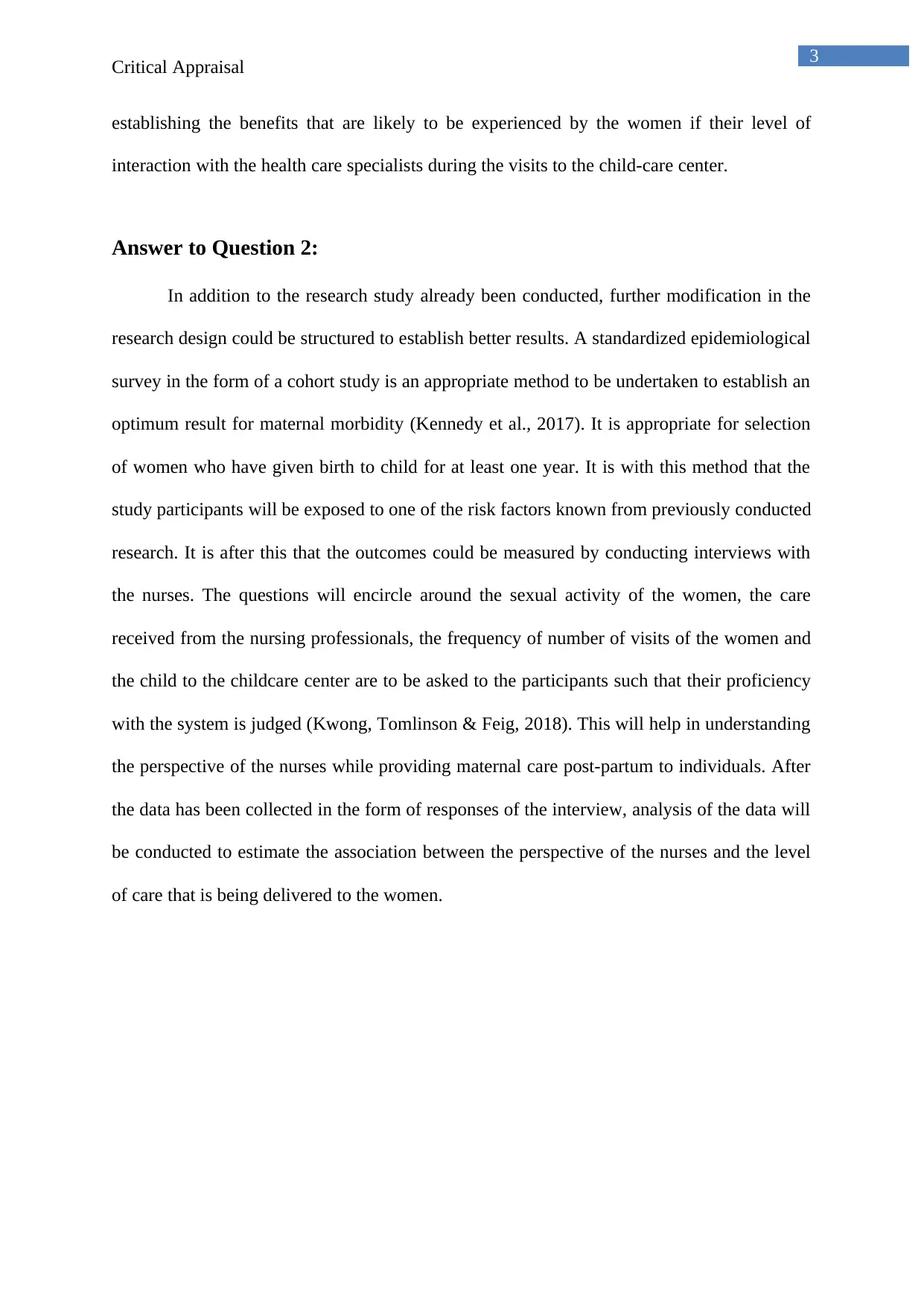
3
Critical Appraisal
establishing the benefits that are likely to be experienced by the women if their level of
interaction with the health care specialists during the visits to the child-care center.
Answer to Question 2:
In addition to the research study already been conducted, further modification in the
research design could be structured to establish better results. A standardized epidemiological
survey in the form of a cohort study is an appropriate method to be undertaken to establish an
optimum result for maternal morbidity (Kennedy et al., 2017). It is appropriate for selection
of women who have given birth to child for at least one year. It is with this method that the
study participants will be exposed to one of the risk factors known from previously conducted
research. It is after this that the outcomes could be measured by conducting interviews with
the nurses. The questions will encircle around the sexual activity of the women, the care
received from the nursing professionals, the frequency of number of visits of the women and
the child to the childcare center are to be asked to the participants such that their proficiency
with the system is judged (Kwong, Tomlinson & Feig, 2018). This will help in understanding
the perspective of the nurses while providing maternal care post-partum to individuals. After
the data has been collected in the form of responses of the interview, analysis of the data will
be conducted to estimate the association between the perspective of the nurses and the level
of care that is being delivered to the women.
Critical Appraisal
establishing the benefits that are likely to be experienced by the women if their level of
interaction with the health care specialists during the visits to the child-care center.
Answer to Question 2:
In addition to the research study already been conducted, further modification in the
research design could be structured to establish better results. A standardized epidemiological
survey in the form of a cohort study is an appropriate method to be undertaken to establish an
optimum result for maternal morbidity (Kennedy et al., 2017). It is appropriate for selection
of women who have given birth to child for at least one year. It is with this method that the
study participants will be exposed to one of the risk factors known from previously conducted
research. It is after this that the outcomes could be measured by conducting interviews with
the nurses. The questions will encircle around the sexual activity of the women, the care
received from the nursing professionals, the frequency of number of visits of the women and
the child to the childcare center are to be asked to the participants such that their proficiency
with the system is judged (Kwong, Tomlinson & Feig, 2018). This will help in understanding
the perspective of the nurses while providing maternal care post-partum to individuals. After
the data has been collected in the form of responses of the interview, analysis of the data will
be conducted to estimate the association between the perspective of the nurses and the level
of care that is being delivered to the women.
Paraphrase This Document
Need a fresh take? Get an instant paraphrase of this document with our AI Paraphraser
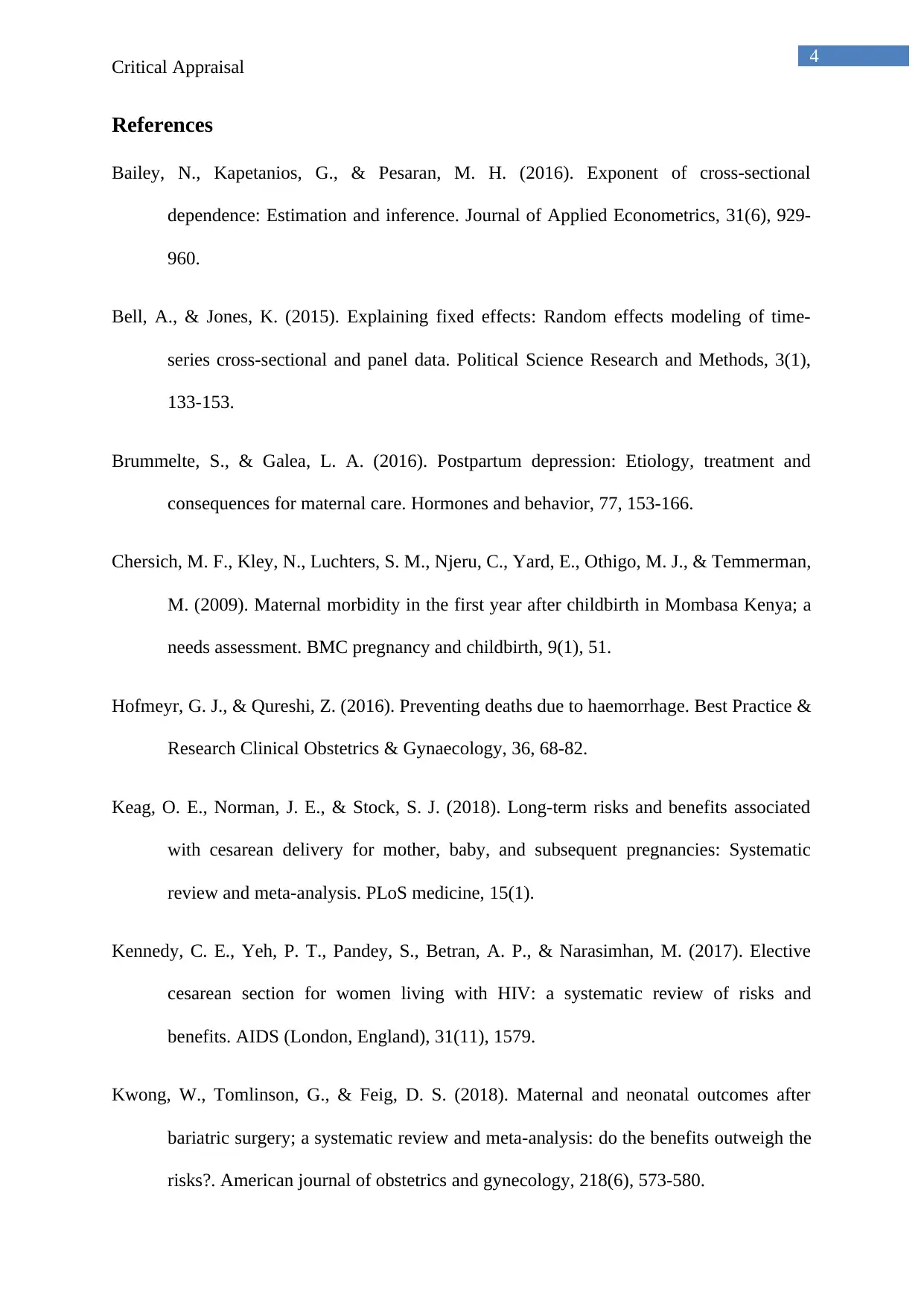
4
Critical Appraisal
References
Bailey, N., Kapetanios, G., & Pesaran, M. H. (2016). Exponent of cross‐sectional
dependence: Estimation and inference. Journal of Applied Econometrics, 31(6), 929-
960.
Bell, A., & Jones, K. (2015). Explaining fixed effects: Random effects modeling of time-
series cross-sectional and panel data. Political Science Research and Methods, 3(1),
133-153.
Brummelte, S., & Galea, L. A. (2016). Postpartum depression: Etiology, treatment and
consequences for maternal care. Hormones and behavior, 77, 153-166.
Chersich, M. F., Kley, N., Luchters, S. M., Njeru, C., Yard, E., Othigo, M. J., & Temmerman,
M. (2009). Maternal morbidity in the first year after childbirth in Mombasa Kenya; a
needs assessment. BMC pregnancy and childbirth, 9(1), 51.
Hofmeyr, G. J., & Qureshi, Z. (2016). Preventing deaths due to haemorrhage. Best Practice &
Research Clinical Obstetrics & Gynaecology, 36, 68-82.
Keag, O. E., Norman, J. E., & Stock, S. J. (2018). Long-term risks and benefits associated
with cesarean delivery for mother, baby, and subsequent pregnancies: Systematic
review and meta-analysis. PLoS medicine, 15(1).
Kennedy, C. E., Yeh, P. T., Pandey, S., Betran, A. P., & Narasimhan, M. (2017). Elective
cesarean section for women living with HIV: a systematic review of risks and
benefits. AIDS (London, England), 31(11), 1579.
Kwong, W., Tomlinson, G., & Feig, D. S. (2018). Maternal and neonatal outcomes after
bariatric surgery; a systematic review and meta-analysis: do the benefits outweigh the
risks?. American journal of obstetrics and gynecology, 218(6), 573-580.
Critical Appraisal
References
Bailey, N., Kapetanios, G., & Pesaran, M. H. (2016). Exponent of cross‐sectional
dependence: Estimation and inference. Journal of Applied Econometrics, 31(6), 929-
960.
Bell, A., & Jones, K. (2015). Explaining fixed effects: Random effects modeling of time-
series cross-sectional and panel data. Political Science Research and Methods, 3(1),
133-153.
Brummelte, S., & Galea, L. A. (2016). Postpartum depression: Etiology, treatment and
consequences for maternal care. Hormones and behavior, 77, 153-166.
Chersich, M. F., Kley, N., Luchters, S. M., Njeru, C., Yard, E., Othigo, M. J., & Temmerman,
M. (2009). Maternal morbidity in the first year after childbirth in Mombasa Kenya; a
needs assessment. BMC pregnancy and childbirth, 9(1), 51.
Hofmeyr, G. J., & Qureshi, Z. (2016). Preventing deaths due to haemorrhage. Best Practice &
Research Clinical Obstetrics & Gynaecology, 36, 68-82.
Keag, O. E., Norman, J. E., & Stock, S. J. (2018). Long-term risks and benefits associated
with cesarean delivery for mother, baby, and subsequent pregnancies: Systematic
review and meta-analysis. PLoS medicine, 15(1).
Kennedy, C. E., Yeh, P. T., Pandey, S., Betran, A. P., & Narasimhan, M. (2017). Elective
cesarean section for women living with HIV: a systematic review of risks and
benefits. AIDS (London, England), 31(11), 1579.
Kwong, W., Tomlinson, G., & Feig, D. S. (2018). Maternal and neonatal outcomes after
bariatric surgery; a systematic review and meta-analysis: do the benefits outweigh the
risks?. American journal of obstetrics and gynecology, 218(6), 573-580.
1 out of 5
Related Documents
Your All-in-One AI-Powered Toolkit for Academic Success.
+13062052269
info@desklib.com
Available 24*7 on WhatsApp / Email
![[object Object]](/_next/static/media/star-bottom.7253800d.svg)
Unlock your academic potential
Copyright © 2020–2025 A2Z Services. All Rights Reserved. Developed and managed by ZUCOL.





